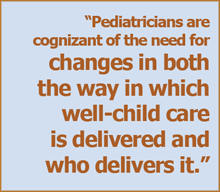Synopsis
Researchers implemented a new well-child care model that uses Internet tools at two pediatric practices within a large HMO. Both parents and providers found the model improved the content and focus of well-child care visits.
The Issue 
Well-child care visits are the primary way children receive developmental and preventive health care. However, because of time, resource, or training limitations on the part of providers, many children do not receive the care they need, and many parents think their children’s developmental or behavioral issues are not adequately addressed. This study tested three improvements to pediatric practice visits: the use of an Internet-based assessment completed by the family before the visit, so the practitioner can tailor the topics addressed at the visit to meet the family's needs; the use of different visit types (e.g., an electronic visit); and the use of extended visits for children with special health care needs.
Key Findings
- Seventy-five percent of parents thought the online pre-visit assessment improved or much improved the well-child care visit.
- Families thought the pre-visit assessment helped them to identify problems and confirm their child was on track developmentally.
- Twelve percent of families had difficulty navigating the online assessment tool and were not able to complete it.
- In general, parents felt satisfied with the e-mail-based electronic visit (or "e-visit") but would not like to see it replace a regular visit.
- Among parents of children with special health care needs, many felt the extended visit gave them the opportunity to communicate with their pediatrician and to bring together the various aspects of their child’s care.
- All participating providers thought the pre-visit assessment was more or much more efficient than the usual well-child care visit, and helpful or very helpful to parents in identifying issues.
Addressing the Problem
Despite a considerable allocation of time and resources, well-child care is not meeting the needs of families. Pediatricians want to do a better job but are constrained by time and resources. Using Internet technology, this new model of well-child care showed promise in engaging parents and tailoring care to meet the needs of families. Further research is needed to assess the impact of the model on health outcomes for children and to better understand the modifications that will be required to use the model with low-income or non-English-speaking families.
About the Study
The authors tested three modifications to the well-child visit: 1) an Internet-based pre-visit assessment tool used by the family so the provider can tailor the content of the visit, 2) an e-visit—a fully electronic visit in which concerns are addressed via e-mail—administered either on its own or in conjunction with a brief provider visit, and 3) an extended visit for children with special health care needs. The model was tested at two practices within Kaiser-Permanente Colorado, a large HMO. Providers and parents were surveyed by telephone to assess their satisfaction.
The Bottom Line
A new model that employs Internet-based tools can help to improve well-child care visits for both families and providers.


